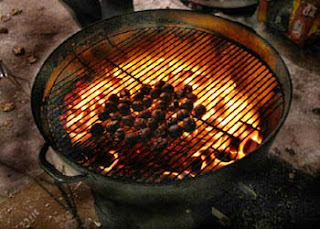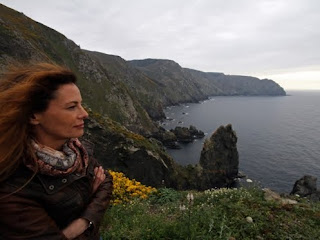 begins with falling autumn leaves, beautiful colors in the fields and sprout mushrooms. The Fall is the perfect time to unleash mushrooms because it is the time that match the appropriate levels of temperature and moisture that fungi need to bear fruit,
begins with falling autumn leaves, beautiful colors in the fields and sprout mushrooms. The Fall is the perfect time to unleash mushrooms because it is the time that match the appropriate levels of temperature and moisture that fungi need to bear fruit, Galicia is a land ideal for mushrooms, there is much water , humidity and temperature, Galicia also hides colorful forests and footpaths that are to be traveled in the fall. Fall characteristic species are the Macrolepiota Galician, Mushroom, the ticket and milk caps. Are the first to leave in autumn, and most wanted to be edible and easy to identify. In addition Galicia abundant chestnut trees in ancient this time its green urchins offer stuffed with chestnuts, chestnut trees once dominated but unfortunately were gradually replaced by a tree of Oceania which acidifies the soil dry: eucalyptus, but especially in the interior of Galicia are still good chestnut that will be detailed later.
To collect mushrooms need a clean bush is very important to recognize the species and not always catch it in doubt, we should go with a knife and a basket or plastic bag or boot. from among the 4,000 different species that occur in Galicia throughout the year, you can see this link most common mushrooms Galicia, there are 8 that are fatal, are "Amanita phalloides, Amanita verna, Amanita virosa, Lepiotas three types of small, one or two types of Cortinarius and Galerina" says Professor Alvaro Martianez. Los chanterelles, for example, give a lot in the pines, as the pines and chanterelles are twinned by mycorrhizal association (mutual benefit).
Video to distinguish boletus.
Events mycological Cambre
The City Council of the Week Micolóxica every year at this time. One of the Galician fairs include experts is the Fungi and Cogumelos Feira de As Pontes, it happens that one of November. This event incluye a tender mushrooms and popular taste. La Casa de las Sciences of São Paulo celebrates all lambs the largest exhibition of mushrooms from Galicia with 200 species, and the 6th and 7th of November happens "Chestnut Festival and Mushroom" in Rivers (SC) and tourists it is the pursuit of program arrow.
Los mejores hills to the Galicia coger arrows
Pinhais coastal sandy areas, he boundary of the province of Pontevedra and Ourense: brakes on Piñor Dining, Mountain of eDRAM, Sand Trevinca Peña, Montes de Hart, Tabeiros Terra de Montes, Fragas Eume the Viriato Mycological Association has a wonderful park on the river Belelle mycology. There are many mountains and forests fit and it's very important at the right time for harvesting is suitable, but we will describe the best areas of Galicia in detail for the good lovers of mycology and best places to pick mushrooms in Spain can be seen in this link .
coastal Pinares the Rías Baixas

For the mushrooms that occur in conifers are ideal coastal pine forests of the peninsula Morrazo and the western part of the Shire of Salnés, we recommend in the pine dune Morrazo Barra, the fragas of Coiro, Lake Castiñeiras, Arquine Chan, Hans de Cela carballeiras and Salnés Hermelo in San Vicente do Mar, Reboredo, Portonovo coastal forests, and Isla de Arousa, ideal places to appreciate the appetizing Cantharellus cibarius. In these forests will have to exercise extreme caution and careful not to confuse the Amanita verna, which is completely white in color, with Agaricus campestris, Agaricus arvensis, Agaricus Agaricus silvicultural and macrosporus, and the Amanita Amanita solitary ovoid, all edible , but its white and similar morphology, could be confused with the deadly Amanita verna. These areas Fall is a veritable oasis for Lactarius Lactarius deliciosus and sanguifluus; portentosum Tricholoma, Tricholoma terreum and Equestrian Tricholoma, with its varidades auratum and flavovirens, Tricholoma fucatum, Hydnum repandum and Hydnum imbricatum, Cantharellus cibarius, Cantharellus lutescens and Cantharellus tubaeformis, Boletus edulis and pinicola Boletus, Russula virescens Russula Russula vesca and cyanoxantha,
forests of the Sierra del Suído

forests in the interior of Galicia, in search of deciduous forest, from Pontevedra to Pontecaldelas and out by the C.531 we Gaxate Oitavos over the river, crossing the bridge and left by the PO-240 will reach the people of Xend, A Griffin, Xesta and Pigarzos, places a major carballeiras of Galicia with its center at A Mead Chapel, oak wood with beautiful views and picturesque setting, under the chapel on the banks of the river abound Xesta alder and oak forests with beautiful grass meadows. This huge oak in the Sierra of Suído its altitude of 800 m. and proximity to the river keeps wetness to enjoy delicacies such as: Boletus reticulatus, aereus Boletus, Boletus edulis and Boletus erythropus, Russula virescens, cyanoxantha Russula, Russula vesca and others; Cantharellus cibarius, Amanita rubescens, Hydnum repandum and Hydnum rufescens
Forests tasting Lalín
About the N-525 from Santiago to Pontevedra, is the town where there are great tasting oak and chestnut forests, right and left of that road deep into the forests can be found delicious fungi: Boletus reticulatus, Boletus edulis, Boletus erythropus, Cantharellus cibarius, Hydnum rufescens, Russula virescens Russula vesca Russula cyanoxantha and, Amanita rubescens, and other types of fungus no less interesting. In the primary forest that falls to the left of the road to Ourense Lalín, scholars in this field, claim that there retire existing oak trees are the largest in Europe since then if you are in Galicia. This forest is worth conservardo and protected by its mass MEJESTUOSA beautiful tree and shrub.
Antas de Ulla Antas de Ulla
In conjunction with Monterroso, Olveda Area, begins the triangle formed by small and very beautiful forests, which still retains much of native tree mass, which sits on land mostly limestone what makes this area an ideal place for development and growth of variety, quantity and quality of mushrooms. In the same triangle there are other places that are preserved with its mass and the same type tree native land, where with a little luck you can find excellent snacks, such as Boletus edulis, Boletus aereus, Boletus erythropus Boletus reticulatus and, among other food and not so edible. The first two are exquisite porcini mushrooms with white flesh, very sought after by the peasantry of the place that the factory dumped on preserving and packaging of Monterroso. In these areas there are large meadows where we can find the coveted "mushrooms" as: Agaricus arvensis, Agaricus campestris and Agaricus macrosporus and the aromatic "sendeiriña" or Marasmius oreades once dry. In the same meadows, edges and roadside habitats very often given to find the most emblematic seta Galicia: procera the Macrolepiota when they appear in the month of October is usually the most sought seta Galicia and northern Portugal. Is a mushroom archiconocidísima sought and food for centuries by the peasantry.
Comarca de Sarria
Straddling counties Monterroso and O Begin and given the existing tree and shrub mass in the region, which include oak, chestnut, birch, poplar, Pinus radiata, Pinus pinaster, which sits on land containing pH that is closer to the limestone that is acid-rich zone fungal specimens. It should go into the woods Piñeira villages and streets, where with any luck we can find Cantharellus cibarius and Cantharellus pallens and tubaeformis variety; aereus Boletus, Boletus erythropus Boletus reticulatus and, Russula virescens Russula vesca cyanoxantha and Russula, Amanita rubescens and Amanita Spisso; Clitopilus prunulus, Hydnum repandum, Hydnum rufescens and Hydnum imbricatum, among other mushrooms no less appreciated. Very close to the towns mentioned is a large forest of conifers (mostly Pinus radiata), known to those parts as "Grandma's Mount, where the autumn season, part of the Boletus pinicola, can be found equestrian and Tricholoma Tricholoma portentosum. In this mountain, both white meat mushrooms as equestrian and Tricholoma Tricholoma are portentosum highly sought.
County O O Incio
Incio is a mountain town, with small and deep valleys that gives you a great variety of landscape. It is one of the municipalities in the province of Lugo that keeps the native tree species, such as among others, oak, chestnut, poplar, walnut, alder, hazel and other species. The relief experienced a sharp decline from the Sierra de O Courel to depression of Monforte de Lemos. From Hospital Incio do we go to Forge Incio, introduced by the LU-642 road that will lead to a small beach, is an excellent starting point for a tour of native forests mycological area, authentic paradise fúngico.Esta area is one of the few places in Galicia where you can find the world famous Amanita Caesarea.
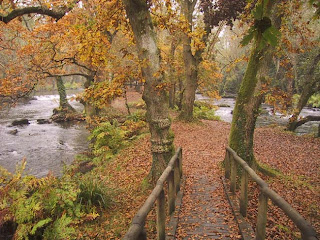 Another point of this route in O Incio is in the tiny village of Saa do Incio. To get to it, since we do Incio Hospital will introduce the LU-643 highway, which runs from this point of Broullón Puebla. After two or three miles out of hospital Begin and to the left of that road we find a sign that signaled the road we will take you to do Incio Saa. From this village we will be moving to cross a small bridge across the river Cabe, whose birth is Foundry located above do Incio. A few meters to cross the bridge, let us introduce cars and walk through the beautiful forest of chestnut , which sets out the scrumptious Incio chestnuts. between the forests of the area do Incio Saa, with a little luck we can find delicious wild mushrooms as Cantharellus cibarius, Cantharellus cibarius v / Cantharellus pallens and friesii, aromatic and pursuing snacks, Boletus reticulatus, excellent white flesh smell countersunk; Russula virescens Russula vesca Russula cyanoxantha and, best of its kind, well suited to the scrambled and omelettes. Of course in the fall this area is even more interesting that the spring season for the amateur or student of the fungal world, since the emergence of mushrooms is extremely varied. In the fall, often leaving the Boletus aereus, the most wanted and best white meat mushrooms and the most consistent of them all, the Boletus erythropus, yellowish flesh when cut change to deep blue, but very tasty, especially if dried and powdered makes their meat and it becomes very aromatic and used to flavor foods, the prunulus Clitopilus with common name of "fariñeira" seta very fragile when it is soaked in water, and with a strong smell of fresh flour , the hepatica Fistulina so coveted and sought after by micofágos. Of course we can also find Cantharellus cibarius, Cantharellus cibarius v / Cantharellus pallens and friesii and no less tasty fungi. For the student of mycology, the region of Incio may be one of the best areas of Galicia, which accounts for a greater number of Ramaria. In fact, around Saa do Incio, is the Ramaria aurea, Ramaria fumigata, Ramaria formosa Ramaria botrytis Ramaria and newly formed.
Another point of this route in O Incio is in the tiny village of Saa do Incio. To get to it, since we do Incio Hospital will introduce the LU-643 highway, which runs from this point of Broullón Puebla. After two or three miles out of hospital Begin and to the left of that road we find a sign that signaled the road we will take you to do Incio Saa. From this village we will be moving to cross a small bridge across the river Cabe, whose birth is Foundry located above do Incio. A few meters to cross the bridge, let us introduce cars and walk through the beautiful forest of chestnut , which sets out the scrumptious Incio chestnuts. between the forests of the area do Incio Saa, with a little luck we can find delicious wild mushrooms as Cantharellus cibarius, Cantharellus cibarius v / Cantharellus pallens and friesii, aromatic and pursuing snacks, Boletus reticulatus, excellent white flesh smell countersunk; Russula virescens Russula vesca Russula cyanoxantha and, best of its kind, well suited to the scrambled and omelettes. Of course in the fall this area is even more interesting that the spring season for the amateur or student of the fungal world, since the emergence of mushrooms is extremely varied. In the fall, often leaving the Boletus aereus, the most wanted and best white meat mushrooms and the most consistent of them all, the Boletus erythropus, yellowish flesh when cut change to deep blue, but very tasty, especially if dried and powdered makes their meat and it becomes very aromatic and used to flavor foods, the prunulus Clitopilus with common name of "fariñeira" seta very fragile when it is soaked in water, and with a strong smell of fresh flour , the hepatica Fistulina so coveted and sought after by micofágos. Of course we can also find Cantharellus cibarius, Cantharellus cibarius v / Cantharellus pallens and friesii and no less tasty fungi. For the student of mycology, the region of Incio may be one of the best areas of Galicia, which accounts for a greater number of Ramaria. In fact, around Saa do Incio, is the Ramaria aurea, Ramaria fumigata, Ramaria formosa Ramaria botrytis Ramaria and newly formed. Ribeira Sacra
In the Ribeira Sacra within the province of Lugo can find large tracts of coniferous, isolated groups of oaks, an occasional chestnut and birch, and good meadows, where we can delight in the pursuit of mushrooms. Passing the village of Sober, we Anllo. Near this village is a large area of \u200b\u200bconiferous forest replanted, often get very close to the Ribeira Sacra Lugo. There are also around oaks and occasional birch, interspersed with conifers and other deciduous trees, although somewhat distant from each other. In the coniferous forest zone Anllo, almost all of Pinus pinaster, if weather conditions are favorable, you can find Boletus pinicola, Cantharellus cibarius, Russula virescens Russula vesca Russula and cynoxantha. If we happen to go in the fall season, we may collect and Boletus edulis Boletus pinicola, Clitopilus prunulus, equestrian and Tricholoma Tricholoma portentosum, Cantharellus cibarius and Cantharellus tubaeformis, and Hydnum repandum Hydnum rufescens, including edible and inedible mushrooms.
In one of the foothills of the Sierra del Torbeo already visible from the road when going by car, there is a large forest of chestnut trees when weather conditions are favorable, you can find exquisite Cantharellus cibarius and its pallens variety, for those parts, is known by the common name of "fine poop." There is also the Craterellus cornucopiodes, over-sized high relative to those often given in other parts of Galicia. Castro Abaixo both, as in Castro's Up, the "poop fine" the octopus prepared as if it were the fair, with hot pepper and all other condiments. The landscape seen from the top of the mountain range Torbeo is simply delusional.
On the steep slopes of the river Sil vines are grown Amandi famous wine, derived from the mencia grape. The Sil canyon is one of the most notable landforms Galicia, taking on both margins of great vantage points to watch and enjoy unparalleled scenic monument that nature gives us for those parts. Sierra
O Courel
The O Courel Sierra is a protected natural area that is as natural limits the Camino de Santiago to the north, the nearby León to the east and the banks of the Sil River to the south. In its size, about 20,000 hectares, many rivers descending from the high mountains forming a beautiful valleys with typical devesas, forests of native vegetation in the Caurel reaching its fullest expression.
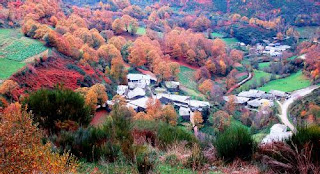 The Chestnut in the Courel The chestnut Souter form one of the most typical landscapes Caurel. This tree, from which we can see ancient trees across the mountains, is closely linked to the lifestyle of the inhabitants of the Sierra. Over the centuries, these people have used their wood to warm in the harsh winter, the fruit for food and animal sleeping on their leaves. The flower (Candea) is used to get honey. The chestnut is a key element of the local cuisine in place of potatoes, and accompanied the pork. The Chestnut Festival is held in November with a free tasting of local produce, wine and queimada and popular craft shows, alternating one year and one in Seoane Folgoso.
The Chestnut in the Courel The chestnut Souter form one of the most typical landscapes Caurel. This tree, from which we can see ancient trees across the mountains, is closely linked to the lifestyle of the inhabitants of the Sierra. Over the centuries, these people have used their wood to warm in the harsh winter, the fruit for food and animal sleeping on their leaves. The flower (Candea) is used to get honey. The chestnut is a key element of the local cuisine in place of potatoes, and accompanied the pork. The Chestnut Festival is held in November with a free tasting of local produce, wine and queimada and popular craft shows, alternating one year and one in Seoane Folgoso. A devesa with many tree species, and these optimal conditions of moisture causes the perfect evolution of fungi and mushrooms. Cat tongues (Hydnum repandum) beef tongue (Fistulina Liver) in addition to several varieties of boletus (Boletus edulis, Boletus pinicola, Boletus aestivales) found in these lush forests ideal habitat. Already in the fields we can find other edible species such as Lepiotas (Macrolepiota Procera), mushrooms (Agaricus Campester) and COPRIN (Coprinus comatus).
For LU-651 highway that runs from Quiroga, by going before the Courel Folgoso to Courel Seoane should visit the small villages and interesting forests, such as: Moreda, Parada, Mercurino, Froxán, Abaixo Ferreira, Ferreira de Arriba, Liñares, among others. To access Seoane Folgoso and also can choose other interesting routes, such as from blacksmith Incio, or from Puebla de dos Montes Broullón to stop. If we walk up the path of Moreda, we will do Cervo Fontes and both side as the other of it if we move a little, beautiful and rare find difficult identification mushrooms and other fungi more easy to define. Of course, given the humidity and the microclimate due to the cutting of the mountains and the coat of the same, you can ensure that this place is a paradise for wild mushrooms and legs. Truly for the curious and especially for the student, the fungal world there exists, perhaps is one of the best places in Galicia. To travel more than two thirds of the trail up the hill we will find the sources of Cervo, which spring from the rocks of the mountain. In one of the springs water springs and other components ferruginous spring water, clear and easily digested, both cold, even in the months of July and August. On the trail plain goats in that place there, find the blueberry plants as well as a number of native plants, including arnica, a plant that is about to disappear and that will be protected. Furthermore, we found several trees such as holly, a tree is protected, yew, conifer very slow growth, hazel, rowan Hunter, among many others who are within the fraga. Other woods that we should not miss or overlook one of the many chestnut trees that exist in the mountains of Courel, is the one located in the village where the poet was born stop Uxío Novo Neyra.
Ancares Mountains National
-VI of A Coruña to Madrid to do Cebreiro Pedrafita, To reach the heart of the Sierra de los Ancares, we must continue our journey from the road Pedrafita LU-723, until reach Campo da Braña (degrades) or by Doiras or by San Román (Cervantes), capital of Lugo Ancares saw. In our view, the ride more comfortable and less risky to be in Campo da Braña, is going to do Cebreiro Pedrafita San Román de Cervantes. Within the municipality of Cervantes is the mountain of Ancares attractive, authentic natural park of Galicia.
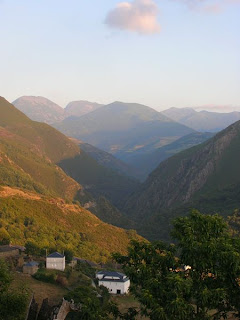 Piornedo are preserved in the Romanesque houses, of Celtic origin, inhabited until quite recently. In Vilariño, stands the castle of Doiras. Brana started in Campo da Cabana Vella route up to three Bispos, on both sides of the trail that crosses the site is a great fraga composed of trees and native plants, a majestic beauty, where appropriate and optimal time Weather conditions can collect mushrooms tasty and nutritious. About degrades and taking the route to San Román de Cervantes, about halfway, there is a large forest cover, made almost all of any type of conifers Pinus silvestris, where with a bit of luck, we can find a delicious dish Boletus edulis called v / fuscoruber. Forest
Piornedo are preserved in the Romanesque houses, of Celtic origin, inhabited until quite recently. In Vilariño, stands the castle of Doiras. Brana started in Campo da Cabana Vella route up to three Bispos, on both sides of the trail that crosses the site is a great fraga composed of trees and native plants, a majestic beauty, where appropriate and optimal time Weather conditions can collect mushrooms tasty and nutritious. About degrades and taking the route to San Román de Cervantes, about halfway, there is a large forest cover, made almost all of any type of conifers Pinus silvestris, where with a bit of luck, we can find a delicious dish Boletus edulis called v / fuscoruber. Forest Castro Caldelas
Around the town of Castro Caldelas are lush forests of oaks, chestnuts and a variety of trees, where you can find delicious edible mushrooms,
County of Trives Pobra
About Pobra of Trives is the small town of Pena Folenche, where you can see good fields for pastures fungi, as well as good forests of chestnuts, oaks and other trees that make the beginning of the imposing Fraga da Pena, taken from the top of that people. On the outskirts of Puebla de Trives can also see good meadows, forests of chestnut, oak and conifers, where we can with a bit of luck finding tasty Agaricus arvensis, Agaricus campestris Agaricus macrosporus and, among others. We can also find the fragrant and tasty "sendeiriña" or Marasmius oreades and the world famous and well known by the peasants of the area, the "boletus" or Macrolepiota procera symbol or coat of the Mycological Association "A Zarrota" Vigo. In these fields you can find other very similar to Lepiota procera Macrolepiota, such as the Macrolepiota rhacodes, excoriated and Lepiota Lepiota naucina, the latter much like the white Amanita, as might be the Amanita virosa and Amanita verna, by what you should not confuse, to avoid unpleasantness and fatal errors. Rising from
Pobra of Trives to Manzaneda, are already beginning to see interesting chestnut and oak forests and beautiful meadows, which also include around Manzaneda. Head to the top of Manzaneda there are large plantations of conifers, almost all of Pinus sylvestris, where the months of October-November-December often find hypothejus Hygrophorus. Although I personally have not had the fortune to find it, it is anticipated that the existing woodland on the plains of Manzaneda head, in March-April, with a little luck and patience to find them, we can also find one the best Hygrophorus, e1 and tasty buscadísimo marzuolus Hygrophorus. And also references of our friends in the Mycological Association "I Lactouros" Monforte de Lemos, and deciduous forests Manzaneda found the much sought after and famous Amanita Caesarea, which means it can be a good habitat for this yummy fungus.
For the forests in the area of \u200b\u200bRua Petín and A, we can find reticulatus Boletus, Boletus edulis, Boletus pinicola, aereus Boletus, Boletus edulis v / Fuscoruber. Unfortunately, except for Boletus reticulatus, ticket typical white flesh is usually out in the spring and summer, the rest will be extinguished completely in the short term, given the brutal manner of collection, in the same manner as was done in the area of \u200b\u200bMonterroso, and what will the medium term from the forests of Galicia.
Valdeorras County should not set aside the existing poplar plantations in the vicinity of O Barco de Valdeorras, places where the habitat can be particularly optimal for finding the "pantorras" common name given to it by the genus Morchella area. Certainly, our mutual friend Christopher Ruiz Leiva, big fan of mushrooms, spring usually prepared succulent dishes, based on Morchella and snails, which at that station form a "mycorrhiza symbiosis."
Within the region of O Valdeorras boat is a must visit even if you put aside the rest of the forest, come and go very carefully Sobreira a beautiful forest (cork in Castilian) located behind Castro Valdeorras, whom we thank you for visiting our friend said Christopher Ruiz Leiva, dotted with plants and shrubs Mediterranean penetration and some other conifer scattered inside and outside the majestic evergreen forests and, once inside, the astonished eyes do not give credit to what they are looking for the first time
The O zone Valdeorras boat, both right and left of the valley that crosses the river Si1, is lined with chestnut trees, oaks and conifers. Also there are large areas of poplar plantations in the form of mushrooms can with a bit of luck to find mushrooms of the genus Morchella, and the range Valdeorrensis,
Forest area and Robledo Rubiá
From the N-120 diverted to the OR-622 will arrive at the fabulous forests and Robledo Rubiá area, where most are centuries-old chestnut and oak, poplar, birch and conifers over 40 years, mass noble tree, and almost all identified many centuries where cantiadad of edible mushrooms for consumption and for sale to the market. If we continue up the mountain from the road Rubiá OR-622, we introduce in the area of \u200b\u200bthe village of Robledo, where there is in my opinion, one of the largest concentrations of brown in Galicia. Are also oaks and conifers, which are expected by their chalky soils and variety of tree mass and shrub that is a paradise for lovers of the fungal world.
Source: The detail of roads and forests has been removed from the magnificent work published by King Alfonso Pazos on the web mycological group "A ZARROTA" where it can be read in its entirety.
